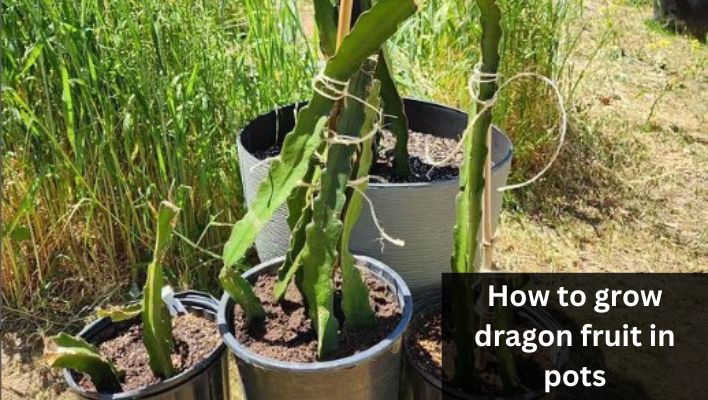Ever wondered how to grow your exotic fruit right in the comfort of your own home? Look no further than the enchanting world of dragon fruit! With its vibrant colors, unique shape, and mouthwatering taste, dragon fruit has become the ultimate must-have for every adventurous gardener.
But here’s the best part: you don’t need a sprawling garden or a green thumb to cultivate this exotic delight. All you need is a pot, a little bit of space, and a whole lot of enthusiasm.
Yes, you heard that right! You can grow your very own dragon fruit right in a pot, making it the perfect choice for urban dwellers, balcony gardeners, and anyone looking to add a touch of tropical splendor to their surroundings.
In this comprehensive guide, we’ll unravel the secrets to successfully growing dragon fruit in pots. From selecting the right container and soil mix to nurturing the plant through its various growth stages, we’ll walk you through each step of the process. We’ll even share tips on proper watering, sunlight requirements, and common pitfalls to avoid.
So, whether you’re a gardening enthusiast seeking a new challenge or simply craving the taste of paradise, join us on this botanical adventure as we dive into the wonderful world of growing dragon fruit in pots. Get ready to unleash your inner dragon and cultivate a bountiful harvest of this mythical delicacy right at home
Choosing the Right Pot, Location, and Soil
Now that you’re ready to embark on your dragon fruit growing adventure, let’s dive into the essentials of selecting the perfect pot, finding an ideal location, and ensuring the right soil conditions.
These factors will play a crucial role in nurturing your dragon fruit plant and maximizing its growth potential.
Pot Size and Material
When it comes to pot size, aim for a container that provides ample room for the dragon fruit’s sprawling nature. A pot with a diameter of 12 to 16 inches (30 to 40 centimeters) works well for young plants, while more mature specimens may require larger containers.
Additionally, opt for pots made of breathable materials such as terracotta or plastic, which allow for better airflow and moisture regulation.
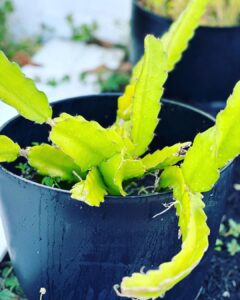
Well-Draining Soil Mix
Dragon fruit plants despise waterlogged conditions, so it’s essential to use a well-draining soil mixture. A combination of cactus potting mix and perlite or coarse sand works wonders. This blend not only ensures proper drainage but also provides the plant with the necessary nutrients and aeration for healthy root development.
Selecting the Right Location
Dragon fruit thrives in bright sunlight, so choose a location that receives at least six to eight hours of direct sunlight daily. Balconies, patios, or sunny windowsills are great options. Additionally, consider the temperature requirements of dragon fruit, as they prefer warm climates. If you live in a colder region, it’s advisable to grow them indoors or in a greenhouse.
Proper Pot Drainage
To prevent waterlogging and promote root health, ensure that your pots have sufficient drainage holes at the bottom.
This allows excess water to escape and prevents the accumulation of moisture that can lead to root rot. You can also elevate the pots slightly using pot feet or by placing them on a raised surface to enhance drainage.
By carefully selecting the right pot size and material, providing well-draining soil, choosing an appropriate location, and ensuring proper pot drainage, you’ll be setting the stage for successful dragon fruit cultivation.
Selecting the Dragon Fruit Variety
When it comes to dragon fruit, there is a dazzling array of varieties to choose from, each with its unique characteristics and flavors.
Selecting the right variety for your pot cultivation is an exciting opportunity to tailor your dragon fruit experience to your climate, taste preferences, and gardening goals.
Let’s explore some popular dragon fruit varieties and their suitability for pot cultivation.
- Hylocereus undatus (White-fleshed Dragon Fruit): The most common variety, known for its vibrant pink or yellow outer skin and white flesh speckled with tiny black seeds. It has a subtly sweet flavor and is a great choice for those new to dragon fruit. This variety adapts well to pot cultivation and is a popular favorite among gardeners.
- Hylocereus polyrhizus (Red-fleshed Dragon Fruit): Featuring a striking magenta or deep red flesh, this variety is visually stunning and boasts a slightly sweeter taste compared to the white-fleshed variety. It thrives in warm climates and is an excellent choice for pot cultivation if you live in a tropical or subtropical region.
- Selenicereus megalanthus (Yellow Dragon Fruit): Known for its vibrant yellow skin and white flesh dotted with small, edible seeds, this variety offers a refreshing, tangy flavor reminiscent of citrus fruits. It requires warm temperatures and plenty of sunlight, making it well-suited for pot cultivation in sunny locations.
- Hylocereus costaricensis (Costa Rican Dragon Fruit): Characterized by its stunning red or purple skin and magenta-colored flesh, this variety boasts a unique, sweet-tart flavor profile. It prefers warm climates and is suitable for pot cultivation if provided with adequate sunlight and warmth.
When selecting a dragon fruit variety for pot cultivation, consider your climate and personal preferences. If you live in a cooler region, opt for varieties that are more tolerant of lower temperatures.
Additionally, consider the size of the pot and the growth habit of the variety you choose. Some varieties have more compact growth habits, making them more suitable for smaller containers.
Ultimately, the variety you choose will depend on factors such as climate, taste preferences, and the space you have available. Whether you opt for the classic white-fleshed variety, the vibrant red-fleshed dragon fruit, or the tangy yellow variety, each offers a unique flavor experience and the opportunity to witness the captivating beauty of dragon fruit as it flourishes in your pot.
Preparing the Potting Mix
Creating the ideal potting mix is crucial for the successful growth of dragon fruit in pots. A well-draining mixture ensures proper moisture balance, root health, and nutrient availability.
Let’s explore a simple recipe to prepare a suitable potting mix that will provide the optimal growing conditions for your dragon fruit.
Ingredients for the Dragon Fruit Potting Mix:
- Cactus Potting Mix: This forms the base of the potting mix and provides good drainage. You can purchase a pre-made cactus potting mix from a garden center or create your own by combining equal parts of regular potting soil and coarse sand.
- Perlite or Pumice: Adding perlite or pumice to the mix improves aeration and further enhances drainage. Aim for a ratio of approximately 1 part perlite or pumice to 2 parts cactus potting mix.
- Organic Matter: Incorporating organic matter into the potting mix helps retain moisture while providing nutrients for the plants. Coconut coir or well-rotted compost are excellent options. Add about 1 part organic matter to 3 parts cactus potting mix.
Instructions for Preparing the Potting Mix:
- In a large container or wheelbarrow, combine the cactus potting mix, perlite or pumice, and organic matter.
- Thoroughly mix the ingredients, ensuring an even distribution of each component. Break up any clumps and ensure uniform consistency throughout.
- Test the potting mix by squeezing a handful in your hand. It should hold its shape without being too compact or excessively loose. Adjust the moisture content by adding a little water if it feels too dry or additional perlite if it’s too wet.
- Once the potting mix is well-mixed and at the desired moisture level, it is ready for use.
Remember, a well-draining potting mix is essential to prevent waterlogging and promote healthy root growth. The combination of cactus potting mix, perlite or pumice, and organic matter provides the ideal balance of moisture retention and drainage for dragon fruit plants.
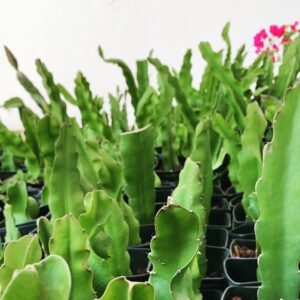
Planting Dragon Fruit Cutting
Now that you have your well-prepared potting mix, it’s time to acquire dragon fruit cuttings and begin the exciting process of planting them in your pots. Here’s a step-by-step guide to help you get started:
Obtaining Dragon Fruit Cuttings
- If you have access to a mature dragon fruit plant, you can obtain cuttings by carefully removing sections of stem segments. Each cutting should be approximately 12 to 18 inches (30 to 45 centimeters) long and contain at least three nodes.
- Alternatively, you can purchase dragon fruit cuttings from a nursery or reputable online supplier. Make sure to choose healthy, disease-free cuttings with intact stem segments.
Callusing the Cuttings
- Before planting, allow the cuttings to dry and callus for a few days. Place them in a warm, dry location away from direct sunlight. This process helps prevent rotting and promotes the development of roots.
Preparing the Pots
- Fill the pots with the prepared potting mix, leaving about 1 inch (2.5 centimeters) of space at the top for watering. Gently press down the mix to eliminate any air pockets.
Planting the Cuttings
- Create a hole in the center of the potting mix using your finger or a dibber. The hole should be deep enough to accommodate the bottom one-third of the cutting.
- Insert the bottom end of the cutting into the hole, making sure that at least one node is covered by the potting mix. The remaining nodes should be exposed above the soil surface.
- Hold the cutting upright and carefully fill the hole with potting mix, gently pressing it around the base to ensure stability.
Watering and Initial Care
- After planting, water the pot thoroughly until water drains from the bottom. Ensure the potting mix is evenly moist, but avoid overwatering, as this can lead to root rot.
- Place the pots in a location that receives ample sunlight, preferably six to eight hours per day.
- Maintain regular watering, allowing the top inch (2.5 centimeters) of soil to dry between watering sessions. Avoid waterlogging the potting mix.
Providing Support
- As the dragon fruit cutting grows, it will require support to climb and spread. Install a trellis, stake, or other support structure in the pot to guide the growth of the vine and prevent it from toppling over.
With the dragon fruit cuttings planted and cared for, it’s time to embark on a journey of growth and watch as your dragon fruit plants establish their roots and flourish.
Providing Optimal Growing Conditions
To ensure the healthy growth and development of your potted dragon fruit plants, it’s essential to provide them with optimal growing conditions.
Let’s explore the ideal temperature, sunlight, and humidity requirements, as well as tips for protecting your dragon fruit from extreme weather conditions and creating a favorable microclimate.
Temperature Requirements
Dragon fruit thrives in warm temperatures, ideally between 65°F and 95°F (18°C to 35°C). Temperatures below 50°F (10°C) can stunt growth or damage the plant. If you live in a region with cooler temperatures, consider growing your dragon fruit plants in containers that can be moved indoors during colder seasons.
Sunlight Exposure
Dragon fruit plants require abundant sunlight to thrive and produce fruit. Aim for at least six to eight hours of direct sunlight per day. Place your pots in a location that receives ample sunlight, such as a south-facing balcony, patio, or sunny windowsill. If you are growing them indoors, provide supplemental grow lights to ensure they receive sufficient light.
Humidity and Air Circulation
Dragon fruit plants prefer moderate humidity levels between 40% and 60%. Adequate air circulation is also crucial to prevent fungal diseases. If the air in your growing area is dry, consider misting the plants occasionally or placing a tray of water nearby to increase humidity. However, avoid excessive moisture on the foliage, as it can lead to fungal issues.
Protection from Extreme Weather
Dragon fruit plants are sensitive to extreme weather conditions. Protect them from strong winds, heavy rains, or prolonged periods of intense sunlight. If you anticipate inclement weather, move your pots to a sheltered area or provide temporary shade using shade cloth or umbrellas. In colder climates, cover the plants with blankets or horticultural fleece during freezing temperatures.
Creating a Favorable Microclimate
To create a microclimate that promotes optimal growth, consider the following tips:
- Use mulch around the base of the plants to retain soil moisture and regulate temperature.
- Provide a trellis or support structure for the vines to climb and ensure proper air circulation.
- Avoid overcrowding the pots, as it can impede air movement and promote disease.
- Prune the plants regularly to maintain an open and well-ventilated structure.
By understanding and meeting the temperature, sunlight, and humidity requirements of dragon fruit plants, as well as protecting them from extreme weather conditions, you’ll create an environment that fosters their healthy growth and maximizes fruit production.
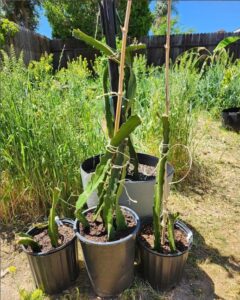
Watering and Fertilizing
Proper watering and fertilizing are key factors in maintaining the health and vitality of your potted dragon fruit plants. Understanding their specific needs will help you provide the right care and support their growth effectively.
Watering Needs:
Dragon fruit plants require regular watering, but it’s crucial to strike a balance to prevent overwatering, which can lead to root rot, and underwatering, which can cause dehydration. Here are some guidelines for watering your dragon fruit plants in pots:
- Water your dragon fruit thoroughly when the top inch (2.5 centimeters) of the potting mix feels dry to the touch. Ensure that water penetrates the potting mix and drains well through the drainage holes.
- Allow excess water to drain completely, as dragon fruit plants do not tolerate waterlogged conditions. Standing water can lead to root rot and other issues.
- During hot, dry periods, you may need to water more frequently to maintain adequate moisture levels. Monitor the moisture content of the potting mix and adjust the watering accordingly.
- In cooler weather or during the plant’s dormant period, reduce watering frequency to prevent excessive moisture retention.
Fertilizing
To support the growth and development of your dragon fruit plants, regular fertilization is necessary. Here are some guidelines for fertilizing your potted dragon fruit:
- Start fertilizing when the plants begin actively growing, typically in spring. Use a balanced, slow-release fertilizer specifically formulated for cacti or succulents.
- Follow the instructions on the fertilizer packaging for the appropriate dosage and frequency of application. Generally, a monthly application during the growing season is sufficient.
- Avoid over-fertilizing, as it can lead to excessive vegetative growth at the expense of fruit production.
- Organic fertilizers, such as compost or worm castings, can also be used to provide additional nutrients. Apply them once or twice a year as a top dressing around the base of the plants.
Remember, proper drainage is essential for dragon fruit plants, both during watering and in the potting mix itself. The potting mix should be well-draining to prevent waterlogged conditions and allow the roots to breathe.
By providing adequate watering, allowing for proper drainage, and fertilizing at the appropriate times, you will promote healthy growth and maximize the potential of your potted dragon fruit plants.
Training and Supporting Dragon Fruit
As your dragon fruit plants grow, providing proper support becomes crucial to ensure their upward growth, prevent sprawling, and maximize fruit production. Let’s explore the need for support and different methods for training dragon fruit plants onto trellises or stakes.
The Need for Support
Dragon fruit plants are epiphytic climbers that naturally seek support to grow vertically. Without proper support, the vines can become tangled, prone to breakage, and less productive. Supporting the plants offers several benefits, including:
- Vertical Growth: Training the plants allows them to grow vertically, maximizing space utilization and preventing excessive sprawling.
- Air Circulation: Supporting the vines promotes better air circulation, reducing the risk of fungal diseases and ensuring overall plant health.
- Fruit Production: Proper support encourages the development of multiple branches, which increases the potential for fruit-bearing sites.
Training Methods
There are several methods for training dragon fruit plants onto trellises or stakes. Here are two commonly used techniques:
- Trellis Training: Set up a trellis system near the pot or container. As the plant grows, guide the main vine along the trellis, securing it gently with soft ties or plant clips. Allow the side branches to spread out naturally, training them to climb the trellis as well. Regularly check the plant’s growth and redirect any new shoots toward the trellis.
- Stake Training: Install a sturdy stake into the pot, close to the plant. Tie the main vine loosely to the stake using soft ties or plant clips. As the plant grows, gently train the side branches to grow upward, securing them to the stake. Prune any excessive lateral branches to focus the plant’s energy on vertical growth.
Regardless of the training method, it’s important to handle the plant with care and avoid damaging the stems or roots. Use soft ties or plant clips that won’t constrict the plant as it expands. Regularly monitor the growth and adjust the ties or clips as needed to avoid constriction or damage.
Remember to provide enough space between the trellis or stake and the plant to allow for airflow and prevent the stems from rubbing against the support structure, which can lead to abrasions.
By training and supporting your dragon fruit plants as they grow, you’ll ensure their vertical development, improve air circulation, and create an organized and productive growth pattern.
Pruning and Maintenance
Regular pruning and maintenance are vital for keeping your dragon fruit plants in optimal shape and ensuring their overall health. Pruning helps promote fruiting, maintains a manageable size, and allows for better airflow.
Additionally, monitoring for pests and diseases is essential for early detection and effective control.
Let’s delve into the importance of pruning, instructions for pruning dragon fruit plants to encourage fruiting and common maintenance tasks.
Importance of Pruning:
Pruning plays a crucial role in the growth and productivity of dragon fruit plants. It helps in the following ways:
- Fruiting Promotion: Pruning stimulates the development of fruiting branches by directing the plant’s energy toward fruit production.
- Size Control: Regular pruning helps manage the size of the plant, preventing it from becoming excessively bushy or sprawling.
- Airflow Improvement: Pruning opens up the canopy, allowing for better air circulation, which reduces the risk of fungal diseases.
Pruning for Fruiting
Follow these guidelines when pruning dragon fruit plants to encourage fruiting:
- Wait until the plant is at least one year old or has reached a height of about three feet (one meter) before initiating pruning.
- Identify the main, thick stems that are at least pencil-thick in size, and select four to six healthy ones to become the primary fruiting branches.
- Remove any lateral branches or side shoots growing from the selected fruiting branches, except for the topmost one or two nodes.
- Trim the selected fruiting branches to a length of about 12 to 18 inches (30 to 45 centimeters) to encourage branching and fruit production.
- Regularly prune back excessive growth and side shoots that emerge from the base or the main stem to maintain the plant’s shape and focus its energy on fruiting.
Maintenance Tasks
Apart from pruning, here are some common maintenance tasks for your dragon fruit plants:
- Pest Control: Monitor your plants regularly for common pests like mealybugs, scale insects, and aphids. If detected, use organic insecticidal soaps or horticultural oils to control the infestation.
- Disease Monitoring: Inspect your plants for signs of diseases such as fungal infections, stem rot, or bacterial spots. Promptly remove and dispose of any infected plant material and consider applying organic fungicides if necessary.
- Weed Management: Keep the area around your potted dragon fruit plants free from weeds that compete for nutrients and water.
- Nutrient Replenishment: Periodically assess the nutrient needs of your plants and consider supplementing with organic fertilizers to ensure healthy growth and fruit production.
Regularly assess the health of your dragon fruit plants, inspecting the leaves, stems, and fruits for any abnormalities. Early detection and intervention are key to maintaining plant vigor and addressing issues promptly.
By incorporating regular pruning, monitoring for pests and diseases, and performing necessary maintenance tasks, you’ll keep your dragon fruit plants in excellent condition, encouraging abundant fruiting and ensuring their long-term success.
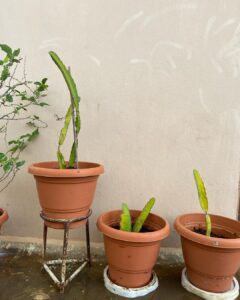
Pests and Diseases
While dragon fruit plants are generally resilient, they can still be susceptible to certain pests and diseases.
Being aware of these common issues and employing organic methods for prevention and management will help keep your plants healthy and thriving.
Let’s identify some common pests and diseases that affect dragon fruit plants and explore organic approaches to address them.
Common Pests
Mealybugs: These small, cottony insects can cluster on the stems, leaves, and fruits, sucking sap and causing yellowing or stunted growth. Control them by physically removing them with a soft brush or cotton swab dipped in rubbing alcohol. You can also apply a mixture of water and organic insecticidal soap to affected areas.
Scale Insects: These pests appear as small, oval-shaped bumps on the stems and leaves. They feed on the sap, leading to leaf yellowing and stunted growth. Remove them manually using a soft brush or cloth soaked in a solution of water and organic dish soap. Alternatively, use horticultural oil to suffocate and control them.
Aphids: These tiny insects gather on the undersides of leaves, causing leaf distortion, yellowing, and a sticky residue called honeydew. Blast them off with a strong stream of water or apply a solution of water and organic insecticidal soap to control their population
Other pests include ants, thrips, spidermites an d many more. It’s worth noting that providing proper cultural practices, such as regular inspection, maintaining plant health, and ensuring a balanced environment, can help prevent and minimize pest infestations.
Common Diseases:
Stem Rot: This fungal disease causes dark, watery lesions on the stems, leading to wilting and plant decline. To prevent stem rot, ensure proper drainage, avoid overwatering, and provide good airflow. If detected, remove infected parts and apply organic fungicides containing copper or sulfur.
Anthracnose: This fungal disease manifests as sunken, dark lesions on the fruits, often surrounded by pinkish spore masses. To prevent anthracnose, practice proper sanitation by removing infected fruits, provide adequate spacing between plants, and applying organic fungicides as a preventive measure.
Bacterial Spot: This disease causes dark, water-soaked spots on the leaves and fruits, leading to rotting and plant decline. Prevent bacterial spots by avoiding overhead watering, providing good airflow, and practicing crop rotation. Remove infected parts and apply copper-based organic sprays to manage the disease.
Organic Prevention and Management:
- Maintain good plant health through proper cultural practices, including regular watering, well-draining soil, and adequate sunlight exposure.
- Ensure proper air circulation around the plants by spacing them appropriately and avoiding overcrowding.
- Implement crop rotation to prevent the buildup of pests and diseases in the soil.
- Use organic fungicides and insecticidal soaps formulated specifically for edible crops, following the instructions on the packaging.
- Encourage natural predators and beneficial insects in your garden to help control pest populations.
- Regularly inspect your plants for signs of pests or diseases and promptly address any issues.
By implementing these organic methods for prevention and management, you can effectively protect your dragon fruit plants from common pests and diseases, promoting their health and ensuring a bountiful harvest.
Harvesting and Enjoying Dragon Fruit
After putting in the effort to grow and care for your dragon fruit plants, the time has come to reap the rewards of your labor. Let’s explore how to determine when dragon fruit is ready to harvest, tips for harvesting and storing, and some delicious ideas for enjoying this exotic fruit.
Determining Fruit Ripeness:
To ensure the best flavor and texture, it’s important to harvest dragon fruit at the right time. Here are some indicators of fruit ripeness:
- Color Change: Most dragon fruit varieties change color as they ripen. Look for vibrant, evenly colored skin. For example, red-skinned varieties may deepen in color, while yellow-skinned varieties may develop a brighter shade.
- Firmness: Gently squeeze the fruit. Ripe dragon fruit should have a slight give, similar to a ripe avocado. However, it should not be overly soft or mushy.
- Easy Separation: The fruit should easily detach from the stem when gently twisted or pulled. If it requires significant force, it may not be fully ripe.
Harvesting and Storage
When your dragon fruit is ready for harvest, follow these steps for optimal results:
- Using clean, sharp pruning shears or a knife, cut the fruit from the stem, leaving a small portion of the stem attached.
- Handle the fruit with care to avoid bruising or damaging the delicate skin.
- Store ripe dragon fruit in the refrigerator, preferably in a perforated plastic bag or container, where it can remain fresh for up to five days.
Enjoying Dragon Fruit
Dragon fruit offers a unique and delightful taste that can be enjoyed in various ways. Here are some ideas for consuming and serving dragon fruit:
- Fresh and Simple: Enjoy the fruit as is by cutting it in half and scooping out the flesh with a spoon. The mild, subtly sweet flavor and refreshing texture make it a perfect snack or addition to fruit salads.
- Smoothies and Juices: Blend dragon fruit with other tropical fruits, such as pineapple and mango, for a vibrant and nutritious smoothie. You can also juice dragon fruit to create a refreshing beverage.
- Desserts: Use dragon fruit in desserts like sorbets, and fruit tarts, or as a topping for yogurt or ice cream. Its vibrant color adds a visually appealing touch to any sweet treat.
- Exotic Salads: Slice dragon fruit and add it to salads with fresh greens, citrus segments, and a light dressing for a unique and colorful salad experience.
- Creative Recipes: Explore creative recipes like dragon fruit salsa, dragon fruit popsicles, or even dragon fruit-infused cocktails for a burst of tropical flavor.
Remember to wash the fruit thoroughly before consuming, and if using the skin for presentation, give it a gentle scrub to remove any dirt or residue.
Now that you have successfully harvested your dragon fruit and discovered exciting ways to enjoy it, savor the flavors and share the joy of this exotic fruit with family and friends. Happy harvesting and bon appétit!
How long does it take for dragon fruit to bear fruit?
The time it takes for dragon fruit to bear fruit can vary depending on several factors, including the growing conditions, variety of dragon fruit, and propagation method. Generally, dragon fruit plants take around 2-3 years to start producing fruit, but it can take longer in some cases. Here are a few factors that can influence the fruiting timeline:
- Propagation method: Dragon fruit plants propagated from cuttings or grafted plants tend to fruit earlier compared to plants grown from seeds. Cuttings or grafted plants are clones of mature plants and have a head start in terms of maturity and fruiting potential.
- Growing conditions: Providing optimal growing conditions, such as proper sunlight, well-drained soil, and appropriate fertilization, can accelerate the fruiting process. Good cultural practices and favorable environmental conditions can help the plant grow faster and produce fruit earlier.
- Variety: Different dragon fruit varieties have varying growth rates and fruiting times. Some varieties may bear fruit earlier than others. It’s important to select a variety known for its productivity and adaptability to your specific climate.
Considering these factors, it’s advisable to be patient when growing dragon fruit as it can take a couple of years for the plant to mature and produce its first fruits. However, once established, a healthy dragon fruit plant can continue to bear fruit for many years, providing a rewarding harvest.
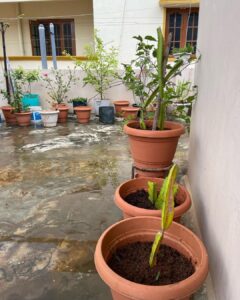
How to Grow Dragon Fruit in Pots FAQs
What size pot is ideal for growing dragon fruit?
The ideal pot size for growing dragon fruit depends on the age and size of the plant. When starting with a young dragon fruit plant, a pot with a diameter of about 8-10 inches (20-25 centimeters) is sufficient.
As the plant grows, it will require larger pots to accommodate its expanding root system. A mature dragon fruit plant typically needs a pot with a diameter of 16-24 inches (40-60 centimeters) or even larger for larger varieties.
How much sunlight does dragon fruit require?
Dragon fruit plants thrive in full sunlight. They require a minimum of 6-8 hours of direct sunlight daily to grow and produce fruit successfully.
Place the plants in a location where they can receive ample sunlight throughout the day. If you live in a hot climate, some partial shade during the hottest part of the day can be beneficial to prevent sunburn on the plants.
Can dragon fruit be grown indoors?
While dragon fruit is primarily grown outdoors, it is possible to grow them indoors under certain conditions. To grow dragon fruit indoors, you will need a well-lit area with sufficient sunlight or artificial grow lights that can provide the plant with at least 6-8 hours of light per day.
Additionally, ensure proper ventilation and airflow to prevent excessive humidity and stagnant air. Indoor dragon fruit plants may require additional care and attention to mimic outdoor growing conditions, such as hand pollination since indoor environments lack natural pollinators like bees.
Can dragon fruit plants be grown from seeds?
Yes, dragon fruit plants can be grown from seeds. However, it’s important to note that growing dragon fruit from seeds is a slower and less reliable method compared to vegetative propagation.
Dragon fruit seeds may take several weeks or even months to germinate, and the resulting plants may not possess the same characteristics as the parent plant.
It is generally recommended to propagate dragon fruit from cuttings or grafting to ensure consistent quality and faster growth.
How often should I water dragon fruit in pots?
Dragon fruit plants require well-drained soil, so it’s important to avoid overwatering. The frequency of watering will depend on various factors such as climate, pot size, and soil conditions.
As a general guideline, water the dragon fruit plant thoroughly when the top inch (2.5 centimeters) of soil feels dry. During hot summer months, you may need to water more frequently, possibly every 7-10 days, while in cooler seasons, watering once every 2-3 weeks may be sufficient.
Adjust the watering schedule based on the specific needs of your plant and the moisture retention properties of your potting mix.
Do dragon fruit plants need support?
Yes, dragon fruit plants require support as they grow. Dragon fruit plants are climbers, and their stems are epiphytic, meaning they attach themselves to structures for support. Without support, the stems can become weak and may bend or break under the weight of the growing plant and fruit.
You can provide support to dragon fruit plants by using trellises, stakes, or other structures that allow the plant to climb and spread out.
As the plant grows, gently tie the stems to the support structure using soft ties or plant clips to prevent damage. Regularly check the plant and adjust the ties as needed to ensure proper support throughout its growth.
Conclusion
Growing dragon fruit can be a rewarding experience, but it requires patience and proper care. The size of the pot plays a crucial role in providing adequate space for the plant’s root system to grow, with larger pots needed as the plant matures. Sunlight is vital for dragon fruit plants, as they thrive in full sun and require a minimum of 6-8 hours of direct sunlight daily.
While dragon fruit is primarily grown outdoors, it is possible to cultivate them indoors with the right conditions, including sufficient light and proper ventilation. However, indoor plants may require additional attention and care to mimic outdoor growing conditions, such as hand pollination.
Although dragon fruit can be grown from seeds, it is a slower and less reliable method compared to vegetative propagation. Propagating dragon fruit from cuttings or grafting is recommended for consistent quality and faster growth.
Watering dragon fruit plants in pots should be done carefully, avoiding overwatering and ensuring well-drained soil. Adjust the watering schedule based on climate, pot size, and soil conditions.
Lastly, providing support to dragon fruit plants is essential to prevent the bending or breaking of stems as they grow. Trellises, stakes, or other support structures can be used, and regular checks and adjustments are necessary to ensure proper support throughout the plant’s growth.
